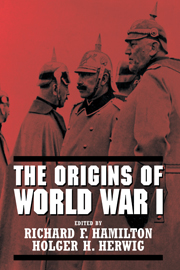Book contents
- Frontmatter
- Contents
- List of Tables and Maps
- Contributors
- Acknowledgments
- 1 World Wars: Definition and Causes
- 2 The European Wars: 1815–1914
- 3 Serbia
- 4 Austria-Hungary
- 5 Germany
- 6 Russia
- 7 France
- 8 Great Britain
- 9 Japan
- 10 The Ottoman Empire
- 11 Italy
- 12 Bulgaria, Romania, and Greece
- 13 The United States
- 14 Why Did It Happen?
- 15 On the Origins of the Catastrophe
- Appendix A Chronology, 1914
- Appendix B Dramatis Personae
- Appendix C Suggested Readings
- Index
2 - The European Wars: 1815–1914
Published online by Cambridge University Press: 05 August 2012
- Frontmatter
- Contents
- List of Tables and Maps
- Contributors
- Acknowledgments
- 1 World Wars: Definition and Causes
- 2 The European Wars: 1815–1914
- 3 Serbia
- 4 Austria-Hungary
- 5 Germany
- 6 Russia
- 7 France
- 8 Great Britain
- 9 Japan
- 10 The Ottoman Empire
- 11 Italy
- 12 Bulgaria, Romania, and Greece
- 13 The United States
- 14 Why Did It Happen?
- 15 On the Origins of the Catastrophe
- Appendix A Chronology, 1914
- Appendix B Dramatis Personae
- Appendix C Suggested Readings
- Index
Summary
Many accounts of the Great War's origins, understandably, focus on the short term, 28 June through to early August 1914. Others, also for good reason, look at the longer term, beginning with 1866 or 1870. The decisions of July and August 1914, after all, were made against a background of several decades of experience.
It is useful to consider an even longer term, the entire period from 1815 to mid-year 1914, the ninety-nine years following the last major conflagration, the world war generated by Napoleon Bonaparte. Twenty-three international wars were fought on the European continent in that period. Roughly half of them were small wars, ones with 10,000 or fewer battle fatalities. Most sources report the Crimean War (1853–56) as the largest of these struggles, with roughly half a million combat-related fatalities. If accurate, it would mean the number of lives lost in that war would have been roughly one-twentieth the number lost in World War I. (One important source reports the Russo-Turkish War of 1877–78 as the largest of those wars, a discrepancy to be considered below in this chapter). The European wars fought in this ninety-nine-year span were relatively small, the four largest being, in sequence, the Russo-Turkish (1828–29), the Crimean (1853–56), the Franco-Prussian (1870–71), and the Russo-Turkish (1877–78). For almost a century, Europe had experienced no world war.
We routinely ask the “outbreak question”: Why the war? But a prior question also deserves consideration: What circumstances made the ninety-nine relatively peaceful years possible?
- Type
- Chapter
- Information
- The Origins of World War I , pp. 45 - 91Publisher: Cambridge University PressPrint publication year: 2003

